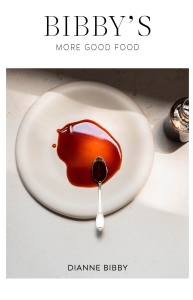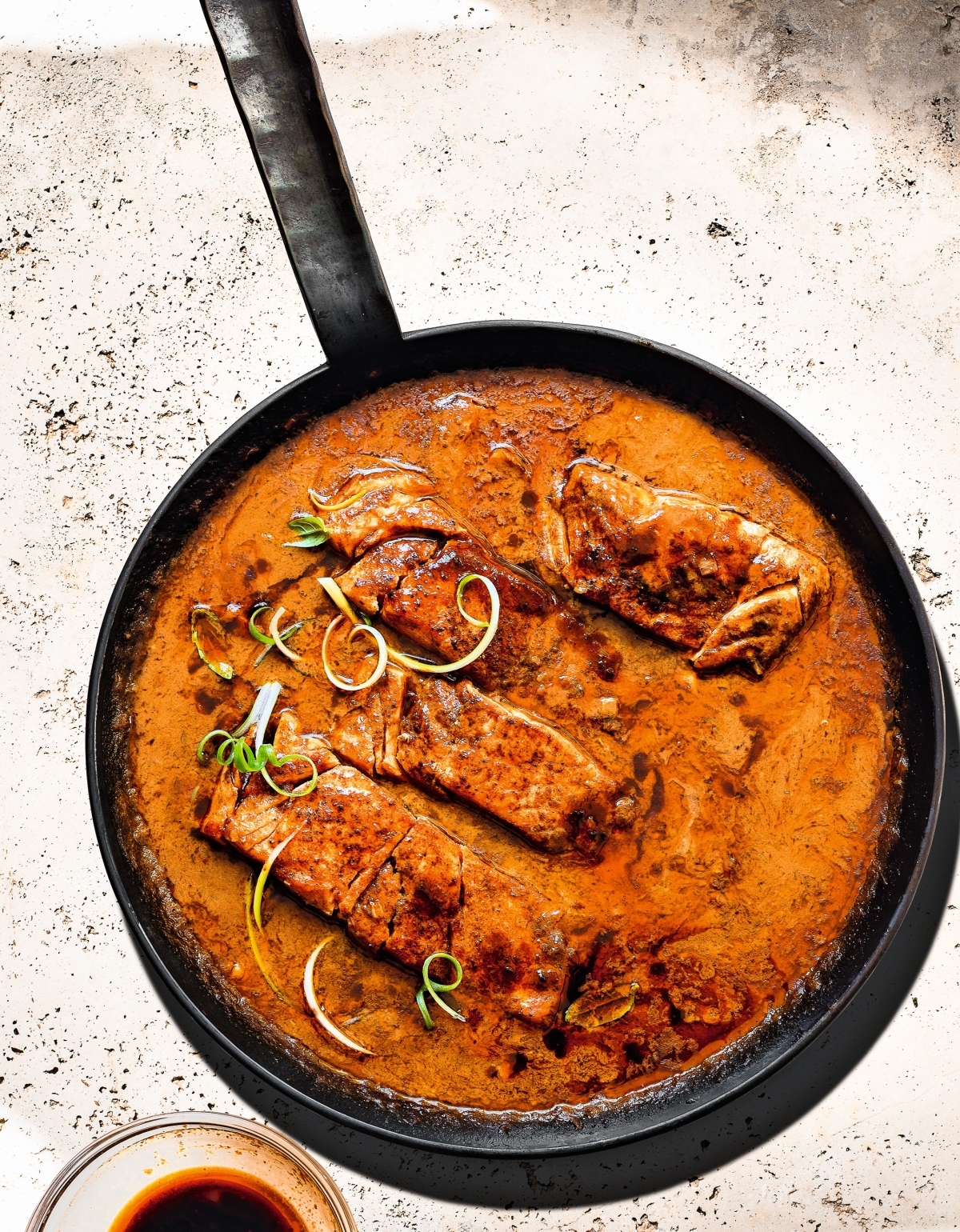
Embrace approachable food made with thoughtful consideration. Many of the recipes in Bibby’s More Good Food are plant-centric without being exclusively vegetarian. Expect an abundance of textural contrast and funky flavour enhancers. The book is divided into nine vibrantly fresh chapters, influenced largely by Middle Eastern and Mediterranean flavours. The busyness of weekdays is balanced with slower weekends, when a few gentler hours in the kitchen are just what’s needed. The doors are thrown open to hospitality, marrying food and creative tablescapes, setting the tone for intimate at-home gatherings. If you’re after food less ordinary, this book is for you.
JUMP TO RECIPE
Coconut Panna Cotta & Granadilla Duo
Red Thai Gochujang Salmon Curry
Weeknight Tuscan Chicken
“You’d be hard pressed to find this recipe on a Tuscan menu, but it does a fine job of conjuring up a romanticised taste of Italy. There’s rosemary, parmesan and sundried tomatoes. How can it not be good? Every time I make this dish, the pan hardly needs rinsing.”
 Serves 4
Serves 4
4 free-range, skinless chicken fillets
5 ml herbes de Provence
2 sprigs of fresh rosemary, leaves picked and finely chopped
fine salt and freshly ground
black pepper
olive oil, for cooking
1 large shallot, finely diced
1–2 cloves garlic, minced
zest of 1 lemon
6–8 sundried tomatoes in olive oil, thinly sliced
60 ml white wine (chenin blanc)
80 ml chicken stock
125 ml fresh cream
5 ml cornflour whisked with 30 ml milk
25 g parmesan, freshly grated
several lemon slices, to finish
Place the chicken between two sheets of baking paper and pound lightly to flatten and tenderise. Season on both sides with the herbes, rosemary, salt and pepper.
Heat 15 ml olive oil in a wide-based pan. Place the chicken in the hot oil and cook without turning, until golden – about 5 minutes. Turn and cook for a further 4 minutes. Remove the chicken and set aside.
Add a little more oil to the pan and sauté the shallots until softened, 6–8 minutes. Add the garlic, lemon zest and sundried tomatoes, and cook for about 2 minutes.
Deglaze with the wine, scraping up all the sticky bits, and reduce slightly. Stir in the stock, cream and cornflour slurry. Bring up to a simmer, then add the parmesan and stir through. Nestle the chicken in the sauce and simmer until reduced and thickened, around 3–4 minutes should do.
Add lemon slices and serve immediately with pan-grilled broccolini, mashed potatoes, pasta, polenta or steamed green beans. Crusty bread is especially good.
Coconut Panna Cotta & Granadilla Duo
“The sign of a good panna cotta is its delicate quiver and silk-like viscosity. Your spoon should glide through the wobbly cream. Do use fresh granadilla pulp rather than tinned. The tang needs to be bright and lively, a necessary contrast to the sweetened cream.”
 Serves: 8–10
Serves: 8–10
JELLY
15 ml gelatine powder
500 ml granadilla juice
125 ml fresh granadilla pulp
30 ml lemon juice
50 g castor sugar
PANNA COTTA
15 ml gelatine powder
250 ml coconut milk
250 ml fresh cream
100 g castor sugar
1 vanilla pod, split and seeds scraped
TO FINISH
125 ml fresh cream
fresh pulp of 2–3 granadillas
For the jelly, sponge the gelatine in 30 ml cold water.
Place the granadilla juice and pulp, lemon juice and castor sugar in a saucepan. Stir over a medium heat until the sugar is dissolved.
Heat the gelatine until dissolved, then add to the warm juice. Whisk well to combine. Pour into a large ring mould or individual pudding moulds. Chill until just set.
For the panna cotta, sponge the gelatine in 30 ml cold water.
In a saucepan, heat the coconut milk, cream, castor sugar and vanilla seeds, stirring all the while. Once tiny bubbles break the surface, remove from the heat.
Heat the gelatine until dissolved, then add to the cream mixture and whisk to combine. Set aside to cool completely. Pour the cream carefully over the set jelly and refrigerate for 3 hours or until set.
To unmould, dip briefly in hot water and invert onto a serving plate. Drizzle with fresh cream and granadilla pulp.
Red Thai Gochujang Salmon Curry
“Our weeknight curry relies on a good store-bought paste and gochujang, a spicy fermented paste popular in Korean cooking. Lemongrass, ginger and garlic add pungency and contrast to the richness of coconut milk and peanut butter. Swap the salmon for chicken – thighs or fillets – if you prefer. While the flavours are complex, the recipe is a cinch.”
 Serves: 4
Serves: 4
coconut oil, for cooking
4 x 125 g salmon fillets
2.5 ml each of ground coriander, cumin and paprika
fine salt
2 shallots, finely diced
2 cloves garlic, minced
15 ml freshly grated ginger
1 stalk lemongrass, outer layer removed and discarded, finely diced
30 ml Thai red curry paste
45 ml peanut butter
10 ml gochujang paste
45 ml soy sauce
22.5 ml lime juice
30 ml fish sauce
15 ml brown sugar
1 x 400 g tin coconut milk
250 ml chicken stock
steamed basmati rice, to serve
spring onions, thinly sliced, to serve
Heat 15 ml coconut oil in a non-stick pan. Season the salmon on both sides with coriander, cumin, paprika and salt. Lay the salmon, skin side down, in the pan and cook for about 4 minutes. Turn and cook for a further 3 minutes, or to your liking. Remove to a plate and cover while you make the sauce.
In the same pan, sauté the shallots until softened, about 6 minutes. Add the garlic, ginger and lemongrass, and cook for 2 minutes. Stir in the curry paste, peanut butter and gochujang paste, and cook for another minute or two.
Add the soy sauce, lime juice, fish sauce and sugar. Pour in the coconut milk and stock, then bring up to the boil. Simmer until reduced and thickened, around 15 minutes should do.
Lay the salmon in the sauce and heat through gently.
Serve with basmati rice, thinly sliced spring onions and toppings of your choice (roughly chopped roasted and salted peanuts, pickled red onion, fresh coriander). Offer with Gochujang Drizzle, if you like.
GOCHUJANG DRIZZLE
Combine 5 ml gochujang paste, 10 ml sesame oil, 10 ml lemon juice, 5 ml honey and a pinch of Maldon sea salt flakes. Drizzle over the salmon just before serving.
Recipe extracted from Bibby’s More Good Food by Dianne Bibby, out now.
YOU MAY ALSO ENJOY
Recipe: Recipes to Die Live for by Sally Andrew









